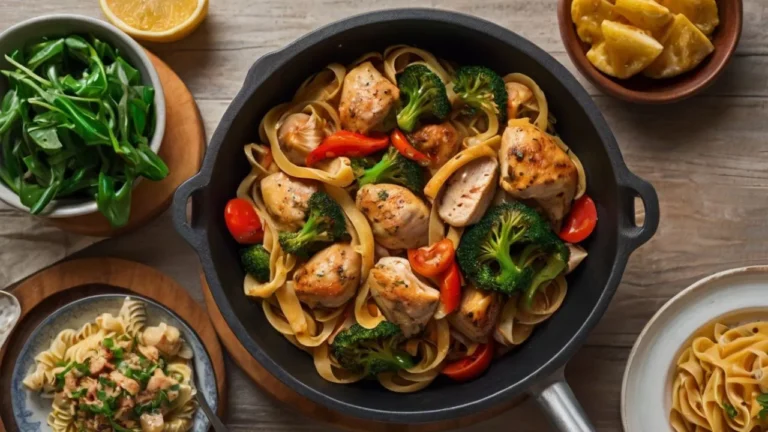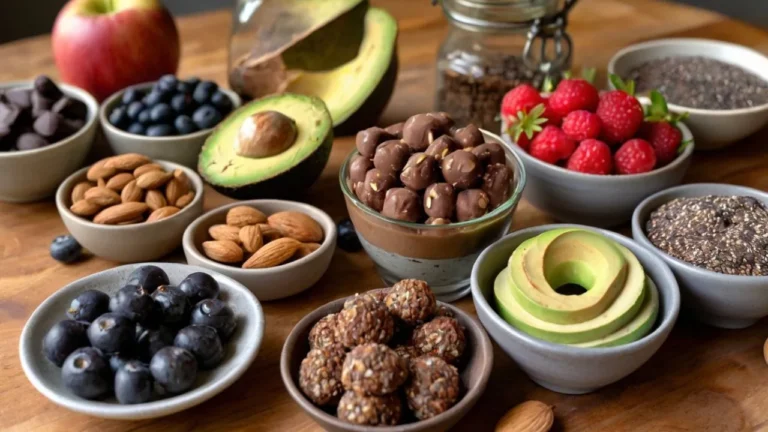Seasonal Recipes: How to Make the Most of Fresh, Local Ingredients
Introduction
Have you ever experienced the joy of eating a juicy, vine-ripened tomato in summer or a hearty bowl of pumpkin soup when the weather turns chilly? Seasonal cooking isn’t just about eating fresh—it’s about connecting with the seasons, the earth, and the local community. It’s a delicious and sustainable way to enjoy meals that are both nourishing and flavorful.
In today’s article, we’ll dive into the many reasons why cooking with seasonal ingredients is so important and how it can benefit your health, your budget, and the planet. I’ll guide you through how to identify and choose fresh, local ingredients, and share some mouth-watering seasonal recipes to try at home. Let’s get started!
Why Seasonal Cooking Matters: The Benefits of Eating Fresh and Local
Flavor, Freshness, and Nutrition
There’s something magical about biting into a strawberry in late spring or savoring a bowl of hot soup made with the freshest winter vegetables. Seasonal ingredients are harvested at their peak, which means they are packed with flavor and nutrients. Unlike out-of-season produce that has to travel long distances, fresh, seasonal ingredients are often more flavorful and contain higher levels of vitamins and antioxidants.
When you eat seasonal foods, you’re getting the best the earth has to offer, at just the right time. These ingredients have been allowed to ripen naturally, soaking up the full essence of the seasons. Think of it as nature’s own flavor-enhancing process.
Sustainability and Supporting Local Farmers
Eating seasonally also supports local farmers and reduces your carbon footprint. In today’s world, many fruits and vegetables are grown halfway around the globe and transported to your local grocery store. This process takes a toll on the environment. By choosing seasonal ingredients grown locally, you’re minimizing the need for long-distance shipping, reducing greenhouse gas emissions, and promoting sustainable farming practices.
Seasonal cooking encourages you to shop locally, whether it’s at a farmer’s market or through Community Supported Agriculture (CSA) programs. This not only helps reduce food miles but also ensures that your money is directly benefiting local growers, fostering a more sustainable food system.
Cost-Effectiveness
Did you know that eating seasonal ingredients can save you money? Produce that’s in season is abundant and often cheaper, especially if you buy it in bulk or take advantage of deals at local markets. Out-of-season items, on the other hand, are often more expensive because they require costly transportation and artificial growing conditions.
By cooking with what’s currently in season, you can enjoy meals that are not only tastier but also easier on your wallet. It’s a win-win situation—better food at a better price!
How to Identify and Choose Seasonal Ingredients
Now that we’ve covered the benefits of eating seasonally, let’s dive into how you can choose and use these ingredients in your meals.
Understanding the Seasons
Seasonal ingredients vary depending on where you live. In warmer climates, you might have access to certain produce year-round, while in colder regions, seasonal foods will change drastically throughout the year. A great first step is to familiarize yourself with the seasonal calendar in your area. Seasonal produce is typically divided into four seasons:
- Spring: Asparagus, strawberries, peas, spinach, rhubarb
- Summer: Tomatoes, cucumbers, zucchini, peaches, berries, corn
- Fall: Pumpkins, apples, sweet potatoes, brussels sprouts, squash
- Winter: Root vegetables like carrots, beets, turnips, and leafy greens like kale and cabbage
A simple way to keep track of what’s in season is to visit a local farmer’s market. You’ll see firsthand what’s currently being harvested in your area. If you’re unsure, many farmers will proudly share what’s fresh, and you can ask them for recipe ideas!
How to Select the Best Seasonal Ingredients
When you’re shopping for fresh, seasonal produce, here are a few tips to ensure you’re getting the best:
- Look for vibrancy: The color of fruits and vegetables is one of the best indicators of freshness. Fresh, seasonal produce tends to be more vibrant and rich in color compared to out-of-season counterparts.
- Smell and touch: Don’t be afraid to give produce a gentle squeeze (when appropriate) or smell it to assess its freshness. A ripe peach will have a sweet aroma, while a tomato should feel firm but slightly give under pressure.
- Choose local: Local produce tends to be fresher and is more likely to be in season, especially at farmer’s markets.
Top Seasonal Ingredients and How to Use Them
Let’s explore some of the best seasonal ingredients and the delicious ways you can use them in your cooking.
| Ingredient | Season(s) | Best Uses |
|---|---|---|
| Tomatoes | Summer & Fall | Fresh salads, sauces, salsas, roasting |
| Pumpkins | Fall & Winter | Soups, pies, roasting, curries |
| Asparagus | Spring | Grilled, in salads, stir-fries, pasta |
| Strawberries | Spring & Summer | Smoothies, desserts, jams, salads |
| Sweet Potatoes | Fall & Winter | Roasted, soups, casseroles, mashed |
Tomatoes: The Summer Superstar
Tomatoes, particularly in the summer, are one of the most versatile seasonal ingredients. From fresh salads to creamy sauces, tomatoes bring brightness and acidity to any dish. Try roasting them with olive oil and herbs, or simply chop them into a salsa for tacos and grilled meats.
Recipe Idea: Summer Tomato and Basil Pasta
Ingredients:
- 4 fresh, ripe tomatoes
- 1 cup fresh basil
- 8 oz whole wheat pasta
- 2 cloves garlic, minced
- 2 tbsp olive oil
Instructions:
- Cook pasta according to package instructions.
- Heat olive oil in a pan and sauté garlic until fragrant.
- Add tomatoes and cook until softened.
- Toss cooked pasta with tomato mixture and fresh basil.
Tip: Add a handful of spinach or roasted chicken for extra nutrition.
Pumpkins: Perfect for Fall
As soon as the air turns crisp in fall, pumpkins are everywhere. These orange beauties are more than just for carving—they’re perfect for making rich soups, hearty stews, and delicious pies. Their natural sweetness also makes them a great addition to baked goods like muffins and breads.
Recipe Idea: Roasted Pumpkin Soup
Ingredients:
- 4 cups cubed pumpkin
- 1 large onion, chopped
- 1 medium carrot, sliced
- 4 cups vegetable broth
- 1 tsp nutmeg
Instructions:
- Roast pumpkin, onion, and carrot at 400°F for 25 minutes.
- Blend roasted veggies with vegetable broth until smooth.
- Heat soup in a pot, add nutmeg, and season to taste.
Tip: Serve with a side of whole-grain bread for a hearty meal.
Easy Tips for Cooking with Seasonal Ingredients
Cooking with seasonal ingredients doesn’t have to be complicated. Here are a few tips to help you make the most of your seasonal bounty:
- Plan Ahead: Take a look at what’s in season and plan your meals around those ingredients. This will ensure you get the freshest produce at its peak flavor.
- Batch Cooking and Preserving: If you have an abundance of a particular ingredient, consider preserving it for later. Freeze, can, or dry fruits and vegetables so you can enjoy them year-round.
- Grow Your Own: You don’t need a massive garden to enjoy fresh produce. Even a small herb garden or a few tomato plants can give you a direct connection to the seasons.
- Experiment with New Recipes: Seasonal ingredients often come with exciting opportunities to try new dishes. Try a new fruit or vegetable in your next salad or stew and let the flavors of the season shine.
Conclusion: Embrace the Seasons in Your Cooking
Cooking with fresh, local ingredients isn’t just about making meals—it’s about celebrating the seasons and all the wonderful produce they bring. From the juicy tomatoes of summer to the hearty pumpkins of fall, seasonal ingredients allow us to enjoy vibrant, nutrient-rich meals that are as sustainable as they are delicious.
By cooking with the seasons, you’re not only making better choices for your health and the environment, but you’re also saving money and supporting local farmers. So next time you’re at the store or the farmer’s market, take a moment to think about what’s in season, and let nature’s offerings guide your menu.
Call to Action
What’s your favorite seasonal ingredient to cook with? Share your thoughts in the comments below, and don’t forget to try one of the recipes from today’s article. Happy cooking, and let’s embrace the flavors of each season together!
FAQ: Seasonal Recipes and Ingredients
Q: How can I make sure I’m choosing the freshest seasonal ingredients?
A: Look for produce that’s vibrant in color, has a pleasant aroma, and feels firm but not overripe. Shopping at local farmer’s markets is a great way to ensure you’re getting fresh, seasonal produce.
Q: What are some easy seasonal recipes I can make with fall vegetables?
A: Roasted pumpkin soup, sweet potato casseroles, and hearty vegetable stews are perfect fall recipes. Try using ingredients like root vegetables, squashes, and greens to create warming, comforting dishes.
Q: How can I preserve seasonal fruits for later?
A: Freezing, canning, and dehydrating are all great ways to preserve seasonal fruits and vegetables. For example, you can freeze summer berries for use in smoothies or make homemade jams to enjoy during the colder months.






